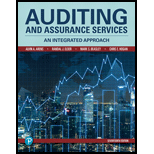
Auditing And Assurance Services
17th Edition
ISBN: 9780134897431
Author: ARENS, Alvin A.
Publisher: PEARSON
expand_more
expand_more
format_list_bulleted
Question
Chapter 13, Problem 5RQ
To determine
Explain the process by which an auditor resolves the apparent inconsistency.
Expert Solution & Answer
Want to see the full answer?
Check out a sample textbook solution
Students have asked these similar questions
Accounting please
Can you explain the correct approach to solve this general accounting question?
Please explain the correct approach for solving this general accounting question.
Chapter 13 Solutions
Auditing And Assurance Services
Ch. 13 - Prob. 1RQCh. 13 - Prob. 2RQCh. 13 - Prob. 3RQCh. 13 - Prob. 4RQCh. 13 - Prob. 5RQCh. 13 - Prob. 6RQCh. 13 - Explain how the calculation and comparison to...Ch. 13 - Prob. 8RQCh. 13 - Prob. 9RQCh. 13 - For each of the eight types of evidence discussed...
Ch. 13 - Prob. 11RQCh. 13 - Prob. 12RQCh. 13 - Prob. 13RQCh. 13 - Prob. 14RQCh. 13 - Prob. 15RQCh. 13 - Prob. 16RQCh. 13 - Prob. 17RQCh. 13 - Prob. 18RQCh. 13 - Prob. 19RQCh. 13 - Prob. 20RQCh. 13 - Prob. 21.1MCQCh. 13 - Prob. 21.2MCQCh. 13 - A conceptually logical approach to the auditors...Ch. 13 - Prob. 22.1MCQCh. 13 - Prob. 22.2MCQCh. 13 - Prob. 22.3MCQCh. 13 - Prob. 23.1MCQCh. 13 - b. Substantive analytical procedures are most...Ch. 13 - Prob. 23.3MCQCh. 13 - Prob. 24DQPCh. 13 - Prob. 25DQPCh. 13 - Prob. 26DQPCh. 13 - Prob. 27DQPCh. 13 - Prob. 28DQPCh. 13 - Prob. 29DQPCh. 13 - Prob. 30DQPCh. 13 - Prob. 31DQPCh. 13 - Prob. 32DQPCh. 13 - Prob. 33DQPCh. 13 - Prob. 34DQPCh. 13 - Prob. 35DQP
Knowledge Booster
Similar questions
- Wayland Manufacturing uses a normal cost system and had the following data available for 2010: Direct materials purchased on account Direct materials requisitioned Direct labor cost incurred Factory overhead incurred Cost of goods completed Cost of goods sold Beginning direct materials inventory Beginning WIP inventory Beginning finished goods inventory Overhead application rate, as a percent of direct-labor costs The ending balance of the direct materials inventory is: a. $82,000 b. $108,000 c. $174,000 d. $92,000 e. None of the above $1,48,000 82,000 1,30,000 1,46,000 2,92,000 2,56,000 26,000 64,000 58,000 125%arrow_forwardPlease provide the solution to this financial accounting question with accurate financial calculations.arrow_forwardPlease provide the accurate answer to this financial accounting problem using valid techniques.arrow_forward
- I am looking for the correct answer to this general accounting question with appropriate explanations.arrow_forwardI am trying to find the accurate solution to this financial accounting problem with the correct explanation.arrow_forwardI need the correct answer to this general accounting problem using the standard accounting approach.arrow_forward
- answer this with correct stepsarrow_forwardWilliams Manufacturing incurred $172,000 in actual manufacturing overhead cost for the current year. The Manufacturing Overhead account showed that overhead was overapplied in the amount of $9,500 for the year. If the predetermined overhead rate was $10.40 per direct labor hour, how many hours were worked during the year?arrow_forwardProvide answerarrow_forward
arrow_back_ios
SEE MORE QUESTIONS
arrow_forward_ios
Recommended textbooks for you
 Auditing: A Risk Based-Approach (MindTap Course L...AccountingISBN:9781337619455Author:Karla M Johnstone, Audrey A. Gramling, Larry E. RittenbergPublisher:Cengage Learning
Auditing: A Risk Based-Approach (MindTap Course L...AccountingISBN:9781337619455Author:Karla M Johnstone, Audrey A. Gramling, Larry E. RittenbergPublisher:Cengage Learning Auditing: A Risk Based-Approach to Conducting a Q...AccountingISBN:9781305080577Author:Karla M Johnstone, Audrey A. Gramling, Larry E. RittenbergPublisher:South-Western College PubBusiness/Professional Ethics Directors/Executives...AccountingISBN:9781337485913Author:BROOKSPublisher:Cengage
Auditing: A Risk Based-Approach to Conducting a Q...AccountingISBN:9781305080577Author:Karla M Johnstone, Audrey A. Gramling, Larry E. RittenbergPublisher:South-Western College PubBusiness/Professional Ethics Directors/Executives...AccountingISBN:9781337485913Author:BROOKSPublisher:Cengage

Auditing: A Risk Based-Approach (MindTap Course L...
Accounting
ISBN:9781337619455
Author:Karla M Johnstone, Audrey A. Gramling, Larry E. Rittenberg
Publisher:Cengage Learning

Auditing: A Risk Based-Approach to Conducting a Q...
Accounting
ISBN:9781305080577
Author:Karla M Johnstone, Audrey A. Gramling, Larry E. Rittenberg
Publisher:South-Western College Pub

Business/Professional Ethics Directors/Executives...
Accounting
ISBN:9781337485913
Author:BROOKS
Publisher:Cengage
